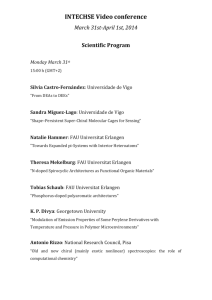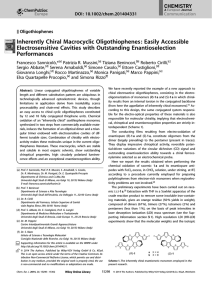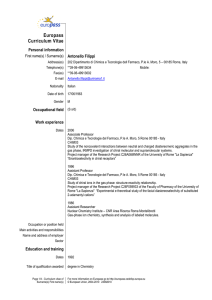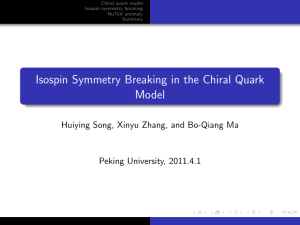0709Supplemental Material
advertisement
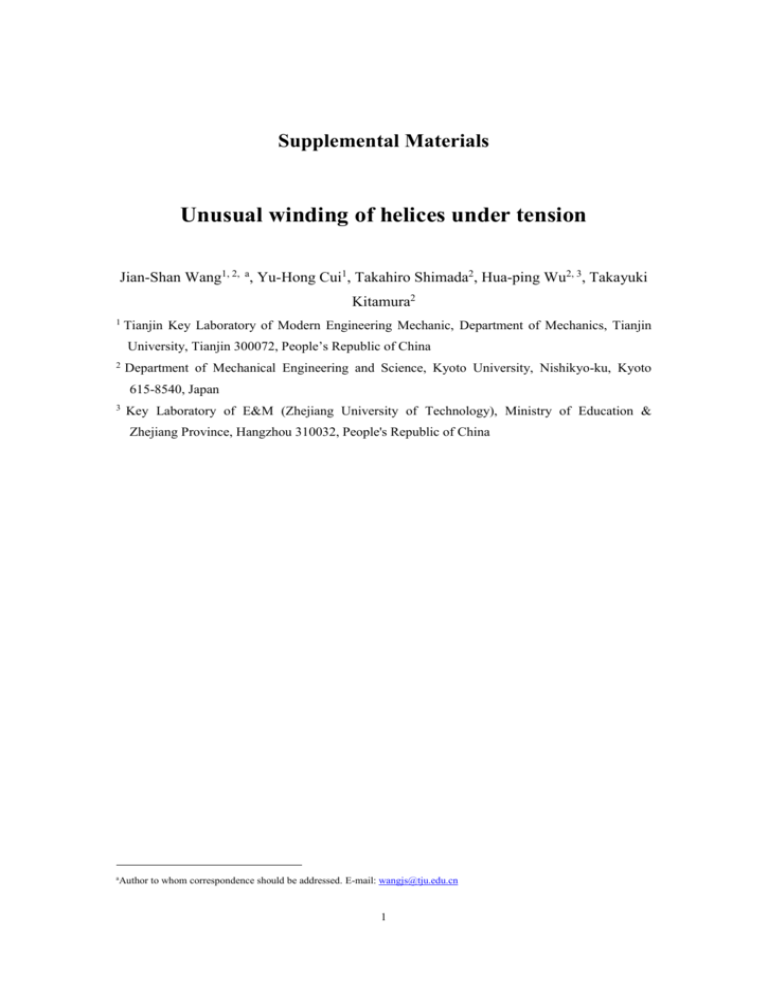
Supplemental Materials Unusual winding of helices under tension Jian-Shan Wang1, 2, a, Yu-Hong Cui1, Takahiro Shimada2, Hua-ping Wu2, 3, Takayuki Kitamura2 1 Tianjin Key Laboratory of Modern Engineering Mechanic, Department of Mechanics, Tianjin University, Tianjin 300072, People’s Republic of China 2 Department of Mechanical Engineering and Science, Kyoto University, Nishikyo-ku, Kyoto 615-8540, Japan 3 Key Laboratory of E&M (Zhejiang University of Technology), Ministry of Education & Zhejiang Province, Hangzhou 310032, People's Republic of China a Author to whom correspondence should be addressed. E-mail: wangjs@tju.edu.cn 1 1. Refined Cosserat rod model of chiral filament We consider a slender chiral filament (rod) with complicated spatial configuration. Following Whitman and DeSilva’s model, 1 the initial configuration CD of the rod can be described by the position vector R( S ) and the direction vector Di ( S ) ( i 1, 2,3 ) at any point on CD . Both R( S ) and Di ( S ) are the functions of the arc length variable S of the non-deformed chiral rod. Similarly, the deformed configuration cd of the chiral rod can be described by r ( s ) and d i ( s) at any point on cd . r ( s ) and d i ( s) are the function of the arc length variable s of the chiral rod. We define the following deformation measures zi and Fi to characterize the deformation of chiral rods.1 zi yi Rˆ Di , i Fi Fi 0 , (s1) in which yi rˆ di r di , Fi 1 1 eijk dk dˆ j eijk dk d j , 2 2 (s2) and, x̂ x S , x x s , x̂ x and d i d j ij . The vectors d i are1 di dii ei , (s3) where e is the orthonormal basis of a fixed rectangular Cartesian system and dii are expressed by the Euler angles as: 1 d11 sin sin cos cos cos , d12 cos sin sin cos cos , d13 sin cos , d 21 sin cos cos sin cos , d 22 cos cos sin sin cos , d 23 sin sin , (s4) d31 sin cos , d32 sin sin , d33 cos . Then, Fi can be expressed in terms of the Euler angles , and as follows:1 2 F1 ˆ sin ˆ sin cos , F2 ˆ cos ˆ sin sin , F3 ˆ ˆ cos . (s5) Considering the stretch-twist and bend-shear coupling deformations, the chiral filament with a spatial configuration has following strain energy function2 H 1 E1 y12 E2 y22 E3 ( y3 1)2 A1 ( F1 F10 ) 2 A2 ( F2 F20 ) 2 2 A3 ( F3 F30 )2 2 D1 y1 ( F1 F10 ) 2 D2 y2 ( F2 F20 ) (s6) 2 D3 ( y3 1)( F3 F30 ) , in which yi and Fi ( i 1 3 ) are the deformation measures of chiral filaments. Fi 0 are the initial values of Fi of undeformed filament. The elastic constants E1 =E2 Jk22 and E3 =k11πa 2 , J is the Timoshenko shear coefficient. The bending rigidities A1 A2 π4 k11a 4 and the torsional rigidity A3 π2 k22a4 . Di are the coupling elastic constants. The internal forces i and internal moments mi of chiral filament can be defined as: i H H , mi , yi Fi (s7) Eq. (s7) can be written as: 1 E1 y1 D1 ( F1 F10 ), 2 E2 y2 D2 ( F2 F20 ), 3 E3 ( y3 1) D3 ( F3 F30 ), m1 D1 y1 A( F1 F10 ), m2 D2 y2 B( F2 F20 ) m3 D3 ( y3 1) C ( F3 F30 ), (s8) (s9) According the equilibrium of the forces and moments on the chiral rod, the equilibrium equations can be obtained as1, 3 ˆi eijk j Fk fi 0 0, mˆ i eijk (m j Fk j yk ) + mi0 = 0, 3 (s10) where x̂ x S , x̂ x , the internal forces (s ) i d i and the internal i 1 3 3 moments m ( s ) mi d i , and eijk is the permutation tensor. i 1 2. Model of helix of chiral filament The deformation measures for the chiral filament can be expressed by the Euler angles , and . If the chiral filament has a helical configuration, then F1 0 , F2 ˆ sin , F3 ˆ cos , F10 0 , F20 ˆ 0 sin 0 and F30 ˆ 0 cos 0 , where 90 h , and 0 and 0 denote the Euler angles in the initial configuration of the filament. 1,3 From Eq. (s6), the constitutive relationship of straight chiral filament can be obtained as: 3 E3 ( y3 1) D3 F3 , m3 D3 ( y3 1) A3 F3 , where y3 1 , E3 π r2 k11 , D3 πr 2k12 , and k11 and (s12) k22 are the extensional and shear moduli of the filament, respectively. The material chirality parameter is C f D32 k2 12 , where and k12 is the coupling A3 E3 k11k12 elastic constant. For a slender filament, the shear deformation can be neglected, and only its axial deformation need be considered: y1 0, y2 0, y3 F D3ˆ D cos 3 ˆ 0 cos 0 1, E3 E3 (s13) where denotes the elongation rate of the filament. The helical radius and pitch of an undeformed helix can be expressed as R0 cos 0 sin 0 and P0 2π , ˆ 0 ˆ 0 respectively. Similarly, the helical radius and pitch of a deformed helix are R y3 sin ˆ and P 2πy3 cos , respectively. When the helix is stretched and ˆ twisted, the increment of the pitch Lp , is given as: 4 Lp 2π D 2π F D3ˆ cos2 3 ˆ 0 cos 0 cos cos cos0, ˆ E3 E3 ˆ 0 and the twist of the helix is L0 sin R l0ˆ . (s14) (s15) According to the equilibrium of forces of helix, the internal forces can be obtained as 2 F sin and 3 F cos . The internal forces and moments of the helix remain constant along the arc length of the filament, so that the second and third formulations ( i 2,3 ) of Eq. (s10) are satisfied automatically. While i 1 , the equilibrium equation of the internal moments in Eq. (s10) becomes ˆ 1 m2 F3 2 y3 m3 F2 3 y2 0. m (s16) Considering mˆ 1 0 and y2 0 , Eq. (s16) can be written as: m2 F3 2 y3 m3 F2 0. (s17) Combining Eqs. (s9), (s13) and (s17) yields: F sin + 1 2 D F sin cos 3 F (ˆ sin 2 ˆ 0 cos 0 sin ) E3 E3 D32 2 ˆ ˆ 0 cos 0 sin ) ( B G )ˆ 2 sin cos (ˆ sin cos E3 ˆ ˆ 0 0, ( B sin 0 cos G cos 0 sin ) where the effective bending rigidity of the chiral (s18) filament is B A1 A2 π4 k11a 4 , and the effective torsional rigidity of the chiral filament π is G A3 2 k22a 4 . The torque acting on the helix is M B (ˆ sin ˆ 0 sin 0 )sin G (ˆ cos ˆ 0 cos 0 ) cos F D3ˆ D D3 ( cos 3 ˆ 0 cos 0 ) cos , E3 E3 (s19) where “ ” represents a right-handed material chirality ( C f 0 ) and “ ” a 5 left-handed material chirality ( C f 0 ) of a filament. Eq. (s19) shows that the torque contributes from the bending, twisting and chirality induced self-twisting of filament. 3. Elastic constants of helix From Eqs. (s14), (s15), (s18) and (s19), we can have ˆ 1 F ˆ , a1 a2 a3 0, l0 F ˆ M F ˆ b1 b2 b3 , c1 c2 c3 0, (s20) where the coefficients ai , bi and ci are given in Appendix. Then, we can obtain the effective elastic constants of helix as Q12 F c2a3 c3a2 1 , Lp c1a2 c2a1 l0 1 M c2a3 c3a2 c a ca Q22 b1 3 1 1 3 b2 b3 , c1a2 c2a1 c1a2 c2a1 l0 (s21) Similarly, we have ˆ F ˆ 0, f1 f2 , h h h 2π F M F b1 f3 , c1 c2 0, h h h h h (s22) where the coefficients f i are given in Appendix. Then, we can obtain Q11 F c2 ˆ M c2b1 c1 f 3 ˆ , Q21 , Lp c2 f1 c1 f 2 2π Lp c1 f 2 c2 f1 2π (s23) References 1A. G. Whitman and C. N. Desilva, J. Elasticity 4, 265 (1974). 2T. J. Healey, Math. Mech. Solids 7, 405 (2002). 3J. S. Wang, G. F. Wang, X. Q. Feng and Q. H. Qin, J. Phys.: Condens. Matter 24, 265303 (2012). 6 Appendix The coefficients ai , bi , ci and f i are given as a1 cos2 , a2 F sin 2 D3ˆ sin 2 D3ˆ 0 cos 0 sin E3 sin , 1 a3 ( F cos2 D3ˆ 0 cos 0 cos E3 cos ). ˆ (A1) D3 cos2 , E3 b2 ( B C )ˆ sin 2 Bˆ 0 sin 0 cos Cˆ 0 cos 0 sin b1 D3 F D3ˆ D2 sin 2 3 ˆ 0 cos 0 sin , E3 E3 b3 B sin 2 C cos2 D32 cos . E3 c1 D 1 sin 2 F 3 ˆ 0 (sin 2 cos 0 sin ) sin , E3 E3 c2 D 1 cos 2 F 2 cos F 3 ˆ 0 (2 cos 2 cos 0 cos ) E3 E3 (A2) D32 2 ˆ 0 (cos 2 cos 0 cos ) ( B C )ˆ 02 cos 2 E3 (A3) ( B sin 0 sin C cos 0 cos )ˆ , 2 0 D3 D2 sin 2 F 3 ˆ 0 (sin 2 cos 0 sin ) E3 E3 ( B C )ˆ 0 sin 2 c3 ( B sin 0 cos C cos 0 sin )ˆ 0 . f1 1 cos 2 , E3 D 1 F sin 2 3 ˆ (sin 2 cos 0 sin ) sin , E3 E3 f3 Bˆ (sin 2 sin 0 cos ) Cˆ (sin 2 cos 0 sin ). f2 7 (A4)
